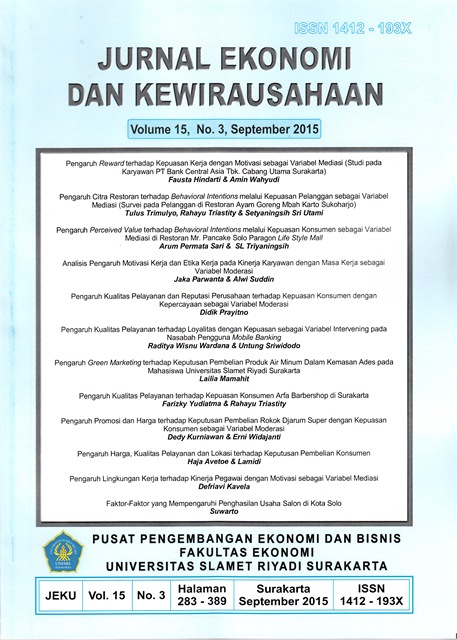PENGARUH PERCEIVED VALUE TERHADAP BEHAVIORAL INTENTIONS MELALUI KEPUASAN KONSUMEN SEBAGAI VARIABEL MEDIASI DI RESTORAN MR. PANCAKE SOLO PARAGON LIFE STYLE MALL
Abstract
The objective of the research are to analyses (1) effect of perceived value to behavioral intentions, (2) effect of perceived value to consumer satisfaction, (3) effect consumer satisfaction to behavioral intentions, (4) effect of perceived value to behavioral intentions, through consumer satisfaction as the mediating variable. Population on this research are all consumer of Hartono Life Style Mall in Solo Baru. The samples of this research consist of 100 responden, taken with convenience sampling. Data collecting with questionnaire technique through validity and reliability test. To test the hypothesis, the researcher uses the path analysis, meanwhile data processing in this research using SPSS program. The result reveals that (1) perceived value have significance effect to behavioral intentions; (2) perceived value have significance effect to consumer satisfaction; (3) consumer satisfaction have significance effect to behavioral intentions; (4) there is a significance direct effect of perceived value to behavioral intentions, through consumer satisfaction as the mediating variable. The conclusion of this research that all hypothesis are supported. Keywords: perceived value, consumer satisfaction, behavioral intentionsDownloads
Published
2016-01-12
Issue
Section
Artikel
License
Authors who publish this journal agree to the following terms:
- Authors retain copyright and grant the journal right of first publication with the work simultaneously licensed under a Creative Commons Attribution License that allows others to share the work with an acknowledgement of the work's authorship and initial publication in this journal.
- Authors can separately make additional contractual arrangements for non-exclusive distribution published by the journal (e.g., publish it in a book), with an acknowledgement of its initial publication in this journal.
- Authors are allowed and encouraged to send their work via online (e.g., in the institutional repositories or their website) after published by the journal.









